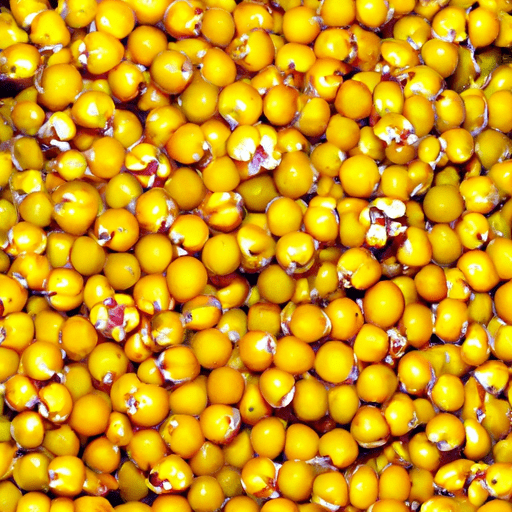Discover the Delightful Sanwa Millet: A Nutritious and Versatile Grain
If you’re searching for a versatile and healthy grain to add to your culinary repertoire, look no further than Sanwa millet! This ancient grain, also known as “barnyard millet,” has been a dietary staple in various cultures for centuries. With its unique taste, impressive nutritional profile, and fascinating history, Sanwa millet is truly a remarkable ingredient that deserves a spot in your kitchen pantry.
Taste and Texture
Sanwa millet possesses a mildly nutty and sweet flavor, with a delicate aroma that adds depth to any dish. The grain itself has a pleasantly chewy texture, similar to rice or couscous. Its light and fluffy nature make it an excellent alternative to other grains, providing a delightful variation in your recipes.
Culinary Uses
One of the standout qualities of Sanwa millet is its versatility in the kitchen. This grain can be used in a multitude of ways, making it suitable for both sweet and savory dishes. Here are a few common uses to inspire your culinary creations:
1. Pilafs and Grain Salads
Sanwa millet serves as a wonderful base for flavorful pilafs and grain salads. Its ability to absorb flavors while maintaining its distinct texture makes it an ideal pairing with herbs, spices, and various vegetables. Consider adding sautéed onions, garlic, colorful bell peppers, and herbs like parsley or mint for a burst of freshness. Enhance the dish further by incorporating toasted nuts or dried fruits for a delightful contrast.
2. Porridge and Breakfast Bowls
Start your day on a nutritious note with a comforting bowl of Sanwa millet porridge. Prepare it similarly to oatmeal, combining the millet with milk or plant-based alternatives, a touch of honey or maple syrup, and a sprinkle of warming spices like cinnamon or nutmeg. Top it off with fresh fruits, a drizzle of nut butter, and crunchy granola for a delightful morning treat.
3. Side Dish Sensation
Elevate your dinner table by serving Sanwa millet as a flavorful side dish. Try cooking the millet with vegetable or chicken broth instead of water to infuse it with additional taste. Once cooked, fluff it up with a fork and season with herbs, such as thyme or rosemary, and a splash of lemon juice to add a zesty twist. This grain pairs wonderfully with roasted vegetables, grilled meats, or as a bed for saucy stews.
Nutritional Value
Beyond its culinary versatility, Sanwa millet boasts an impressive nutritional composition. It is naturally gluten-free and packed with essential nutrients that promote overall well-being. Here are a few key nutritional highlights:
- Fiber: Sanwa millet is an excellent source of dietary fiber, supporting digestive health and providing a feeling of satiety.
- Protein: This grain is rich in plant-based proteins, making it an ideal choice for vegetarians and vegans looking to increase their protein intake.
- Vitamins and Minerals: Sanwa millet contains essential vitamins and minerals, including iron, magnesium, and B vitamins, contributing to overall vitality and energy levels.
Fun Facts and History
- Sanwa millet is believed to have originated in Southeast Asia and has a long history of cultivation in China, India, and parts of Africa. It has played a crucial role in these regions as a dietary staple due to its hardiness and nutritional value.
- The name “barnyard millet” originates from the plant’s appearance, as the flower heads resemble the barnyard weed, as well as its ability to grow well in marginal lands.
- Apart from culinary purposes, Sanwa millet also finds application in traditional medicine in various cultures due to its purported health benefits.
With its fantastic taste, versatility, and impressive nutritional benefits, Sanwa millet undoubtedly deserves a place in your kitchen. Whether you’re exploring new culinary horizons or aiming to incorporate healthier grains into your diet, this ancient grain is here to deliver. Get creative, experiment, and let Sanwa millet take your dishes to new heights!
Sanwa Millet
Origin: Sanwa Millet, also known as Japanese Millet or Echinochloa esculenta, is a species of cereal grain belonging to the family Poaceae. It is native to East Asia, particularly Japan, and has been cultivated there for thousands of years.
Common Uses: Sanwa Millet is primarily used in Japan as a staple food and as an ingredient in various traditional dishes. It is often cooked and eaten like rice, either plain or as a base for other ingredients. It is also ground into flour to make noodles, pancakes, and other baked goods.
Nutritional Benefits: Sanwa Millet is a nutritious grain with several health benefits. It is a good source of carbohydrates, dietary fiber, and protein. It is also rich in essential minerals such as iron, magnesium, and phosphorus. Additionally, it contains vitamins like niacin (B3) and vitamin A.
Unique Properties: Sanwa Millet has several unique properties that make it special. One of these is its ability to grow in waterlogged conditions, making it suitable for cultivation in areas with high rainfall. It is also considered a gluten-free grain, making it an excellent alternative for individuals with gluten intolerance or celiac disease.
Historical Significance: Sanwa Millet has a long history in Japanese cuisine and culture. It has been cultivated and consumed in Japan for thousands of years, with records of its consumption dating back to the Jomon period (14,000 to 300 BCE). The grain has played a significant role in Japanese cuisine, particularly in regions where rice cultivation was less practical. Even today, it retains its cultural value and continues to be an important ingredient in traditional dishes.




Use the share button below if you liked it.
It makes me smile, when I see it.